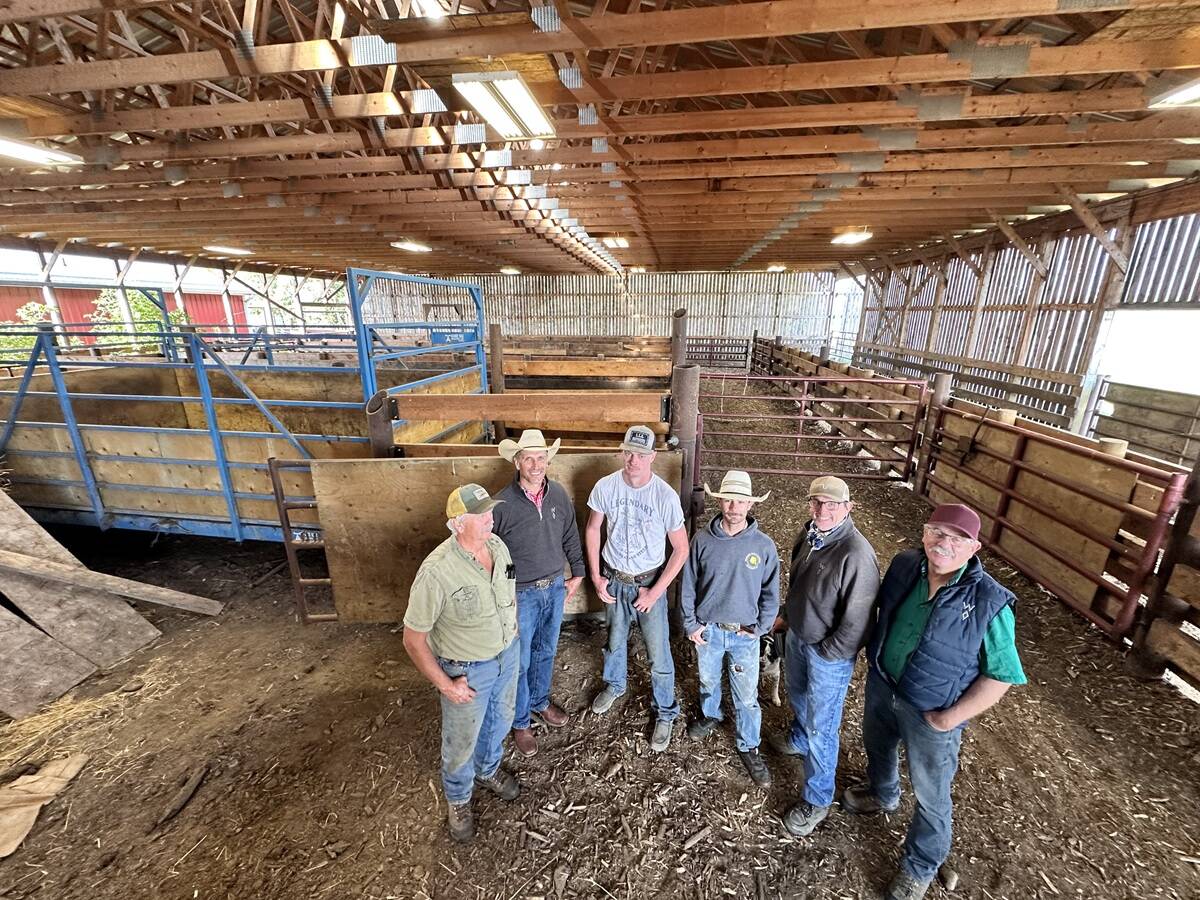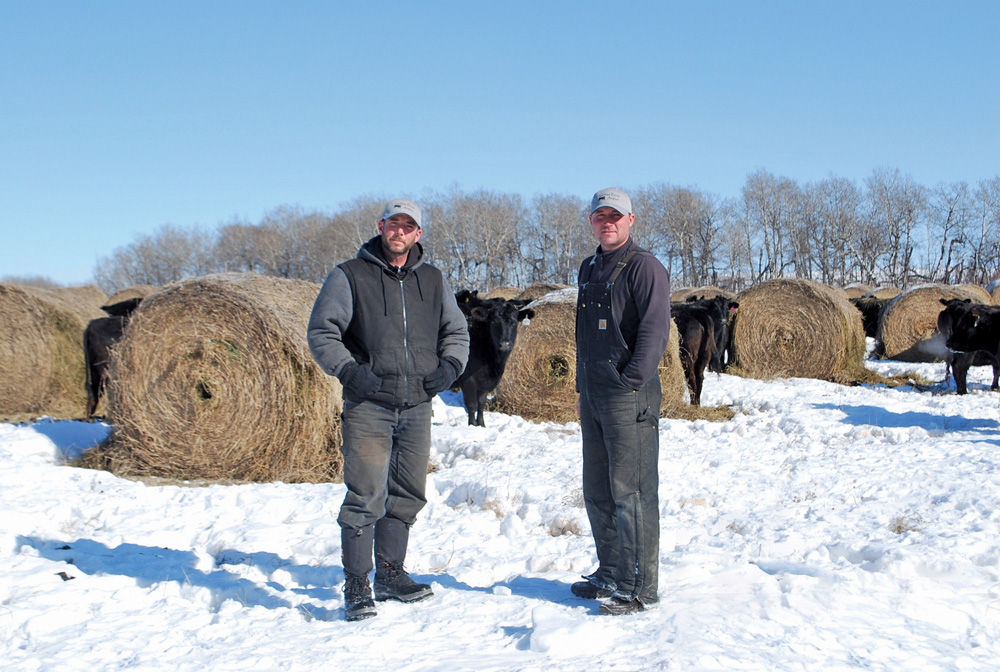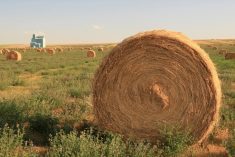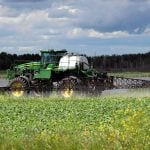The Nerbas family’s grazing program wouldn’t be the success it is without cattle that thrive in a forage-only system and the breeding program wouldn’t be the success it is without quality forage to optimize the cattle’s genetic potential.
Figuring out how to mesh everything together to support three families has been a work in progress as brothers Arron and Shane take over from their parents. Trying times for beef producers dating back to trade issues related to BSE in 2003, followed by repeated flooding of their most valuable haylands since 2006 made earning this year’s Manitoba Environmental Stewardship Award that much more special for the family.
Read Also

Farm families work together to graze cropland with cattle in the fall
These Alberta farm families have separate operations, but work together to manage their land
Today, Arron and his wife Amber, along with Shane, and his wife Sacha, own and operate Nerbas Bros. Angus with their parents, Gene and Cynthia Nerbas, who are easing into retirement. The young up-and-coming fourth generation, Emerson, Hailey, Cash and Kane, is now in the wings.
The family runs 75 registered Angus cows alongside a 525-head commercial Angus herd on 5,500 acres of owned and rented pasture and hayland in the Assiniboine River Valley near Shellmouth in west-central Manitoba.
The terrain is perfect for raising cattle, varying from fertile lowlands to upland sand plains with everything in between including ample bush and hills for shelter and lots of natural freshwater sources.
The major production challenge has been coping with the loss of 1,100 acres of hayland through flooding, including 730 acres of high-quality tame forage that has reverted to native wetland grasses with little more than salvage value in years when it is usable for grazing or haying.
While they have no control over the flooding, their experience in holistic management during the past 12 years has helped them adapt to whatever the weather and markets bring their way.
On the forage side, Arron talks about ways they have been working to increase the productivity of pastures on higher ground.
Winter bale grazing has been one of the most successful strategies for improving lower-quality soils and reducing winter feeding costs. The only aspect they didn’t like was regularly having to move the electric wire to control access to the bales, and always needing to put cows back on the right side of the wire.
The solution has been what they’ve coined as “pod grazing.” The pod is a tightly placed group of bales set on about five acres of land most in need of improvement within a larger existing paddock with permanent fencing. Each of the five or six pods needed for the winter is placed in its own paddock for hassle-free grazing and moving from one to the next. The pods are set up in fall and all 600 mature cows winter together from after weaning in early December into April when they start grazing stockpiled pastures.
The goal of the pod setup is to leave the area completely covered with residue to improve organic matter content and water retention. They estimate that this boosts forage production tenfold across the pod acres and, if properly managed with rotational grazing during the summer months, there shouldn’t be a need to pod that spot again for many years, if ever, Arron says.
Another approach to improving pasture productivity has been reintroducing legumes, such as alfalfa, clover, vetch and cicer milkvetch, to fix nitrogen, add diversity, and improve feed quality. Broadcasting seed and feeding seed in the mineral mix to let the cows do the planting have been somewhat successful in a patchy sort of way, so they are counting on their recently purchased Haybuster drill to give them an even catch.
Cicer milkvetch is turning out to be their preference as a pasture legume even though it’s not the cows’ first choice. Unlike alfalfa, it holds its leaves for late-season grazing and has the added advantage of being a super snow trap and a great deer decoy.
Overall, they estimate that forage production has doubled across their pastures since the early 2000s when they implemented a take-half-leave-half rotational grazing system allowing 90 days of rest before returning to a paddock. They now have approximately 100 permanent paddocks in place and use single-strand, high-tensile electric wire for cross-fencing as needed.
As the carrying capacity of the summer pastures increased, they began working to lengthen the grazing season with stockpiled forage. So far, they’ve added six weeks of grazing in fall and at least a month at the front end by starting in April, versus the traditional start at the end of May. Plenty of new green growth in the bottom of the tall stockpiled grass makes ideal calving grounds in May. Paddocks grazed before June 20 are then rested for stockpile grazing the next year. This year they have 1,400 acres of stockpiled forage to count on.
Each season begins with a grazing plan mapped out for eight months, but they know from experience that they have to be prepared to adjust on the fly as each growing season unfolds. Heavy snow cover in this region most years is the biggest obstacle to extending the grazing season, while water quantity and quality for the cattle gives them quite a bit of flexibility.
They have worked with their local conservation district and tapped into resources available through the Environmental Farm Plan program to protect waterways, sloughs and dugouts from degradation. Riparian and other sensitive areas are fenced off for use in ways that limit grazing and loafing. Off-site watering during summer is provided with solar-powered portable water troughs and by shallow-buried pipeline where feasible.
It’s dicey in their area to rely on solar power alone to keep the stationary water troughs in commission, but the combination of solar and wind power has proven to be reliable.
Experience has also shown them that grazing the commercial herd in two groups rather than 525 pairs together is the best fit for their rotation.
“We could increase stocking density quickly with one large group, but we found it limits our flexibility to have cows grazing where we need them to be at certain times of the year, and having two herds gives us flexibility to run through the lowlands faster,” Arron says, adding that they’ve noticed that the cows seem much more relaxed and content grazing and moving in smaller groups than as one large group.
As for the flooded lowlands, he doubts that the tame species will ever regenerate from the seed bank because of the perpetually saturated soil and the sod-forming nature of the wild wetland hay. Reseeding is just too risky because if new stands ever did become established, they could be lost again so quickly in the next flood.
“Considering the current state of the land, continual flooding and saturated soil, we feel letting the native grass come back is the best for the land and our operation with respect to erosion, leaching and riverbank stability,” he explains.
Never knowing from year to year what usable portion they might get makes planning and budgeting very difficult. Generally, they hope to graze or hay the lowlands whenever ground conditions allow cattle or equipment to be on the land without causing damage.
For summer grazing, they’ve found strip grazing with the use of temporary electric wire is the best approach to encourage the cows to consume this low-quality forage that’s not very palatable. Contrary to their usual practice, they don’t always leave half because the next flood could take that, too.

The farm was largely self-sufficient in hay production before the flooding years. Now, they budget to buy-in about 75 per cent of what they need and mix whatever they salvage from the lowland with the good-quality hay at a ratio of one to three bales, respectively, in their bale grazing setup for wintering the mature herd.
The bred heifers and yearling bulls, along with the heifer calves and bull calves selected as potential breeding stock from the current calf crop, are wintered with their contemporaries in pastures where hay is rolled out every four days or so. Calves not retained for their breeding program or sale as breeding stock are sold after weaning to local backgrounders, feedlots or through local auction markets.
The farm has been home to a commercial Angus herd since their grandparents’ time, with the registered herd growing from a pet project back in their 4-H days of the early ’90s.
The registered cow herd supplies bulls for the commercial program and they’ve totally eliminated buying-in bulls, or any cattle for that matter, since they began using artificial insemination on their registered cows in 2003. They now use some of their home-grown bulls from the AI program as herd sires for the registered cows as well.
“It’s important to have the right type of animal for your system, so we have to be really picky selecting genetics and replacement heifers we think will do well in our forage-only system,” Aaron explains.
The year 2003 also marked their first year selling bulls by private treaty on a first-come basis directly from the farm. They’ve been building this end of their business by connecting with like-minded producers, through word of mouth and their repeat-customer base, and actively showcasing farm life, their grazing program and their cattle on social media.
They now sell about 65 registered and commercial bulls annually, totalling more than 700 through the years. Five years ago they dipped into the female side selling 100 open replacement heifers a year and look forward to expanding this revenue stream.
“We are comfortable where we are now with the number of cattle and land base. Our goal is to continue on the path of regenerative management that will hopefully allow us to leave the land in better condition than when we started,” Arron says.
To learn more about their operation, visit www.nerbasbrosangus.com, nerbasbrosangus.blogspot.ca, and twitter.com/NerbasBrosAngus, where you’ll find the February 2017 pod-grazing time-lapse video, or call 204-773-6800.

















